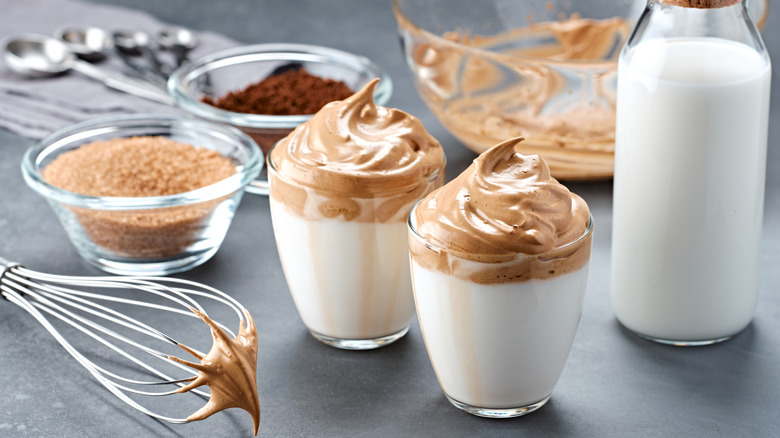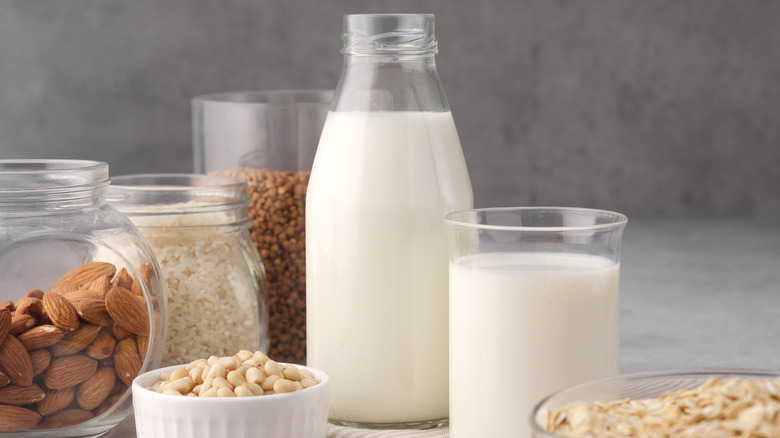The Foolproof Method For Frothing Milk At Home
There's a reason why 60 million people worldwide visit Starbucks weekly, and it's not just for the free Wi-Fi (via Reference). While unlimited internet access is a nice touch, it's the company's specialized coffee and foamy drinks that really drive us to and from this popular café. Caramel macchiatos, pistachio lattes, and blonde cappuccinos — life just wouldn't be the same without these velvety beverages in our hands.
Still, these drinks can be equally expensive as they are tasty. For example, the Starbucks website estimates that a grande chai tea latte with oat milk costs $7.00. If the average coffee-consumer visits Starbucks six times a week (per Comfy Living), their love for chai tea lattes would set them back over $2,000 yearly. Yikes.
But if it's possible to make most of these drinks at home, why do so many venture out to their local popular coffee establishments? Is it the mixes the baristas use, the freedom to hack the menu, or the overall ambiance of the café? Personally, we think it's all of this, plus the layer of sweetened-frothed milk on top. It's basically liquid gold.
Unlike everyday coffee pots, espresso machines have a steam wand attachment. Espresso Canada explains that this piece repeatedly pumps hot air into the milk, causing it to bubble, thicken, and froth. However, these steel machines can run anywhere between $400 and $700 (via Home Grounds). Luckily, there's another way to obtain this professional-grade foam, and you likely already have the tools to make it.
Making frothed milk is simpler than you think
While espresso machines may produce some pretty amazing steamed milk for lattes, a cappuccino's thick froth requires a little extra manual work. One of the best ways to achieve this is through a French press, a small container used to aerate warmed milk. But if this handy gadget is out of reach, a pot and a hand mixer will work just fine.
Chef Kunal Kapur, host and judge of MasterChef India, suggests using 2 cups of milk to make a professional-grade cappuccino. With the stove set to medium-high heat, allow the milk to warm until it is just about the boil. Then, place 1 cup into a mixing bowl while the other continues to boil. It is important that the latter portion reaches 212 degrees, or it could possibly curdle. Use the hand mixer to aerate the separated milk until it begins to froth and foam, becoming almost twice its original size. Finally, pour your boiling milk on top of an instant coffee and sugar mixture before adding the foamed layer.
Still, there's an even simpler way to make frothed milk, and all it requires is a glass jar. Starting with cold milk, Starbucks At Home recommends filling the Mason jar halfway before sealing the lid and shaking it repeatedly. This introduces those same bubbles into the milk and allows it to aerate, doubling in size after only 30 seconds. Then, heat and serve with your brewed beverage.
Different milks can reap varying results
According to the Food Network, various kinds of milk can produce different outcomes. For a thick, whipped layer of sweetened foam, it is suggested to use whole milk due to its high concentration of fat, protein, and sugar. Much like ice cream, these nutritional contents will produce a texture that is both creamy, rich, and smooth — perfect for any warm drink.
Milk with a lower fat concentration, such as 2% or skim milk, can still be used for frothing, though it may be a bit more challenging. Notably, 2% acts more similar to whole milk than skim, and Ricardo Cuisine reports that the latter will not produce as thick or creamy foam. Instead, it may become overly bubbly and watered down. But if you still prefer milk with a lower fat content, investing in a small handheld milk frother may be worth your time.
Plant-based dairy products like oat, almond, or soy milk can be the hardest to froth. However, that doesn't mean it can't be done. Both almond and oat milk reign over soy milk for their naturally creamy texture and sweetened taste. Coffee Affection recommends using a steam wand or milk frother to achieve those perfect bubbles. On the other hand, warmed almond milk has frothing characteristics that act similarly to dairy milk. Ricardo Cuisine notes that it can create sturdy foam with a delicate mouthfeel. For soy milk, it is recommended to stick with a latte-specific brand for a more rich foam.


